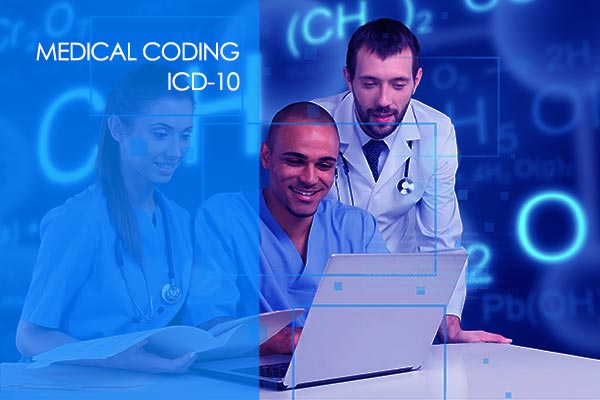1 Training Hour
26 Videos
21 Topics
44 Practice Questions
About Medical Billing and Medical Coders
ICD-10-CM is a detailed diagnostic and morbidity classification system, developed by the World Health Organization, specifically tailored to meet the requirements of American health care. This system goes beyond its predecessor ICD-10 with an increased level of detail that provides greater diagnostics specificity necessary for proper medical coding in our nation.
Not only does the system provide procedural terminology, titles and language that accurately reflect current medical services in America, but it also consists of 68,000 diagnosis codes. Therefore, this training course is crucial for medical coders and administrators to comply with revised standards. Moreover, transitioning to ICD-10 is essential for many reasons – one being its widespread acceptance within the US healthcare industry. Due to its outdatedness, ICD-9-CM does not permit for equitable claims payments. With the same code assigned to significantly different procedures and limited coding options, DRGs cannot be accurately determined either. As a result, it is impossible for healthcare professionals to assess quality of care using this classification system.
Accurately assessing the efficacy of new treatments and medical conditions is difficult when there are not exact coding methods. Our primary focus should be to bolster our capacity for gauging healthcare services delivered to those in need, supporting clinical judgement, documenting public health developments, studying medicine and its effects on people’s lives, recognizing fraudulence or misuse of funds; all while restructuring payment systems so that costs remain reasonable.
About Our Course for Coding Specialists
When you’re ready to start your journey in the medical coding and billing profession, deciding which training program best suits your needs is essential. That’s why IT Certs Training’s online training program is the ideal option for those looking for comprehensive training on demand.
As a Medical Coder, you can work in almost any medical setting imaginable – clinics, hospitals, doctor’s offices and beyond.
More About Medical Coding and Billing:
Medical coding and billing is a crucial function in the healthcare industry that involves translating medical procedures, diagnoses, and services into standardized codes for documentation, reimbursement, and compliance purposes. Medical coders and billers play a vital role in ensuring accurate and efficient healthcare billing processes, maintaining patient records, and facilitating effective communication between healthcare providers, insurance companies, and patients.
Knowledge Benefits:
The Medical Coding and Billing course provides a comprehensive understanding of medical terminology, anatomy, physiology, disease processes, and the coding systems used in healthcare, such as ICD-10-CM, CPT, and HCPCS. This course equips you with the knowledge to accurately assign codes to medical procedures, diagnoses, and services, ensuring proper reimbursement and compliance with industry regulations. Additionally, you will gain proficiency in understanding medical documentation, insurance claims processing, healthcare privacy and security regulations, and electronic health record (EHR) systems.
Career Benefits:
Completing a course in Medical Coding and Billing opens up a range of career opportunities in healthcare organizations, including hospitals, clinics, insurance companies, and billing companies. With this certification, you can pursue roles such as Medical Coder, Medical Biller, Coding Auditor, Coding Compliance Specialist, Medical Claims Analyst, or Revenue Cycle Manager. These roles offer stability, job security, and opportunities for growth and advancement in the healthcare industry.
Job Opportunities:
Upon completing the Medical Coding and Billing course, you can explore various job opportunities, including:
1. Medical Coder: Assign accurate codes to medical procedures, diagnoses, and services for billing, reimbursement, and statistical purposes.
2. Medical Biller: Process medical claims, verify insurance coverage, and ensure accurate and timely reimbursement from insurance companies.
3. Coding Auditor: Review medical documentation and coding practices to ensure compliance with coding guidelines, policies, and regulations.
4. Coding Compliance Specialist: Monitor and enforce coding standards, conduct audits, and provide education on coding compliance to healthcare providers and coding staff.
5. Medical Claims Analyst: Review and analyze medical claims to identify errors, discrepancies, and trends, and resolve billing issues for timely reimbursement.
Salary Potential:
Salaries in the field of medical coding and billing can vary based on factors such as experience, location, certifications, and job responsibilities. Entry-level positions typically offer salaries ranging from $30,000 to $40,000 per year. With experience and specialized certifications, such as Certified Professional Coder (CPC) or Certified Coding Specialist (CCS), you can expect higher earning potential. Experienced medical coders and billers can earn salaries ranging from $45,000 to $60,000 per year or more, depending on their expertise and the complexity of coding and billing processes in their work setting.
Conclusion:
Medical Coding and Billing course provides you with the knowledge and skills necessary to pursue a rewarding career in the healthcare industry. With expertise in medical terminology, coding systems, documentation, and compliance, you can contribute to accurate medical billing, efficient healthcare operations, and regulatory compliance. The field of medical coding and billing offers stable employment, growth opportunities, and a chance to make a significant impact in the healthcare sector. By acquiring a certification in Medical Coding and Billing, you can embark on a fulfilling career path in a vital aspect of the healthcare industry.
Using IT Certs Training for Medical Coding and Billing 10 Certification
IT Certs Training is an online training company that provides comprehensive training programs for various IT certifications, including Medical Coding and Billing 10. The program offers several benefits, making it the best option for obtaining this certification:
1. Flexibility:
IT Certs Training provides self-paced online courses that allow learners to study at their own pace and schedule. This flexibility is particularly useful for working professionals who want to obtain a certification while continuing to work.
2. Comprehensive Curriculum:
The IT Certs Training curriculum covers all the topics and skills required to pass the Medical Coding and Billing 10 certification exam. The program provides videos, practice tests, and study materials that are designed to help learners master the exam objectives.
3. Experienced Instructors:
The program instructors are experienced professionals who have extensive knowledge and expertise in IT Networking and CyberSecurity in addition to many other areas of expertise. They provide guidance and support to learners throughout the training program.
4. Exam Preparation:
IT Certs Training provides exam preparation materials, including practice exams and study guides. These resources help learners prepare for the certification exam and increase their chances of passing it on the first try.
5. Cost-Effective:
The IT Certs Training program is cost-effective compared to other training programs. The program offers affordable pricing and provides value for money by offering comprehensive training and exam preparation resources.
Course Outline
Module 1: Certain Infectious and Parasitic Diseases
Module 2: Neoplasm
Module 3: Diseases of the Blood and Blood Forming Organs
Module 4: Endocrine, Nutritional and Metabolic Diseases
Module 5: Mental Disorders
Module 6: Diseases of the Nervous System
Module 7: Diseases of the Eye and Adnexa
Module 8: Diseases of the Ear and Mastoid Process
Module 9: Diseases of the Circulatory System
Module 10: Diseases of the Respiratory System
Module 11: Diseases of the Digestive System
Module 12: Diseases of the Skin and Subcutaneous Tissue
Module 13: Diseases of the Musculoskeletal System and Connective Tissue
Module 14: Diseases of the Genitourinary System
Module 15: Pregnancy, Childbirth, and the Puerperium
Module 16: Newborn (Perinatal) Guidelines
Module 17: Congenital Malformations, Deformations and Chromosomal Abnormalities
Module 18: Symptoms, Signs and Abnormal Clinical and Laboratory Findings
Module 19: Injury, Poisoning and Certain Other Consequences of the External Causes
Module 20: External Causes of Morbidity
Module 21: Factors Influencing Health Status







Reviews
There are no reviews yet.